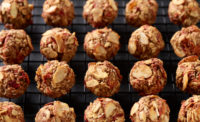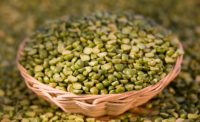It’s no secret that consumers want healthier snacks, and perhaps the biggest indication of this trend is the surge in demand for high-protein offerings—and brands’ overwhelming response in product introductions.
According to Mintel, Chicago, there has been a 54 percent increase in the development of high-protein foods in the U.S., with the claim appearing on 2 percent of all new food products launched across the board. In the end, American product introductions with high-protein claims accounted for a fifth of those released worldwide in 2013, with American introductions twice the number of those of its closest rival, India, which experts see as a clear indication of the trend’s monumental strength in the U.S. (“U.S. consumers have a healthy appetite for high protein food,” Mintel, January 2013).
These new product launches are meeting consumer demands revealed in data from the International Food Information Council (IFIC), which found that 63 percent of consumers look for protein content when purchasing a packaged food or drink product, and 57 percent are trying to get as much protein as possible into their diet (“Food & Health Survey 2015,” IFIC, May 2015).
Many variables are at play here. First, says Jean Heggie, strategic marketing lead, DuPont Nutrition & Health, St. Louis, consumers are snacking more, “on average, consuming 2.8 snacks per day and, due to their busy lifestyles, are more likely to choose snacks as an alternative to a traditional meal. In making these choices, they are choosing snacks that offer more nutritional value, and protein is one of those nutrients that they are specifically looking for in the snacks they are choosing.”
David Whitmer, corporate director of quality, research and development, and innovation, MGP Ingredients, Atchison, KS, notes, “Grain-based foods have a perception of being wholesome and good for you.” Adding protein to such products can incrementally up the food’s better-for-you appeal.
Protein-rich offerings also have especially strong appeal when it comes to niche markets like athletes and active adults, says Grace Harris, director of applications and new business development, Hilmar Ingredients, Hilmar, CA. Such products fit into post-workout offerings, as well as sports nutrition overall. Additionally, she says, “satiating protein content helps with weight management and weight loss.” This means that protein’s appeal is twofold: It not only appeals to the widespread desire for products boasting healthier nutrient panels overall, but also zones in on specific groups searching for protein.
Formulation considerations
Though dairy and vegetable proteins have traditionally been the most-popular options in food fortification, brands operating in the space today have a whole range of ingredients at their disposal. “Ingredient companies have started offering specialty cocktails of proteins, such as pea, hemp and microalgae, to expand the toolbox for formulators,” says Matt Patrick, technology, applications research and technical sales, Delavau Food Partners, Philadelphia. “Each type of protein has its strengths and weakness, and formulators must take advantage of the former, while managing the latter.”
Indeed, perhaps the biggest “weakness” when it comes to protein fortification is a change in the final product’s texture. “Many proteins have a tendency to absorb moisture over time,” explains Heggie, “so high-protein bars or snacks can sometimes dry out or harden over time, resulting in undesirable taste and texture effects, and limited shelf life.”
In an effort to combat this issue, Heggie has observed many companies opting for seeds, nuts and grains, as opposed to powders, to achieve a “natural look” while increasing protein content. “However, it is often difficult to get to high protein levels with these components alone,” she explains.
As a result, Heggie says she is seeing increased interest in using soy products, including a new 90 percent soy-based protein her company offers that is especially appropriate for crunchy textures. The ingredient can work in ways that don’t compromise texture, she says, “either through a crispy piece that blends well with nuts, seeds or grains, or by incorporating it more discreetly into a compound coating or as part of the binding matrix that holds a clustered snack or bar together.”
Dan Force, product manager, Prinova USA, Carol Stream, IL, says beef protein isolate still has a place in appropriate snack foods, including savory bars or trail mix—and it’s approved by USDA for up to a 30 percent inclusion rate. “With a price point comparable to beef,” he says, “there is practically no added cost to boosting your protein.” New beef protein isolate and hydrolyzed chicken protein isolate each contain more than 90 percent naturally isolated protein from their respective sources. “They also have the added benefit of being allergen-free and Paleo-friendly,” he adds.
Protein and baked goods
When it comes to breads and other bakery products—a new frontier in the protein trend—there are many considerations at the formulating stage. First, says Ron Heddleson, senior director of research and development, QualiTech, Chaska, MN, bakery formulators need to determine where they are willing to fall on the allergen scale. “Many protein sources are primary allergens—wheat, soy, dairy,” he explains. “These protein sources must be declared as potential allergens on labels, and care must be taken to manage and segregate them within the supply chain.”
There are many basic protein sources from which to choose, and within each of those overall categories are many additional varieties. For example, not all soy proteins are created equal, notes Heggie. “Depending on the application or type of snack you are trying to make, one might be preferred over another, due to its specific functional characteristics,” she says.
That’s why DuPont recently introduced a concept library, demonstrating the versatility of soy across formats and featuring “a wide range of different soy protein ingredients that deliver the functionality required of the specific snack format featured,” Heggie explains. The snack forms featured in the library include sweet and savory options ranging from nutrition bars to extruded snacks, clusters and baked formats.
Choosing the right protein grows complex when it comes to baked goods because, regardless of the protein type chosen in the end, doughs become increasingly viscous and difficult to mix when high levels of protein are added, says Heddleson. Protein can also impact the stickiness and handling properties of dough, and reduce the loaf volume of breads. Further, “increased levels of protein fortification can result in increased Maillard (nonenzymatic) browning of baked goods,” he says, “impacting the finished product color in an undesirable way.”
To combat this, bakers can opt for protein-rich inclusions, based on soy, wheat, whey, brown rice, dairy, peas and more. Heddleson notes the availability of a proprietary, stabilized corn-germ ingredient that features 18 percent protein content. He also recommends pea protein as an option in bakery applications, due to its relatively low allergenicity and mild taste profile.
Ody Maningat, Ph.D., vice president of research and development and technical services, Manildra Milling Corp., Shawnee Mission, KS, recommends wheat-based proteins, which blend easily with other dry ingredients in a formula. “The only consideration that formulators have to watch for is water absorption,” he emphasizes, since wheat proteins absorb twice their weight in water. The company offers a range of wheat-based protein ingredients, ranging from 75 to more than 90 percent protein content.
Due to all the considerations formulators need to weigh when adding protein to their products, Mark McKnight, senior vice president of sales and marketing, RiceBran Technologies, Scottsdale, AZ, recommends they take the process in stages. “First, start off with replacing only 10 percent of your empty carbohydrate ingredients with the nutrient-rich and protein-fortified ingredient,” he says. “Make adjustments to water content and other binding agents as needed. Second, increase from 10 percent to 15, 20 or 25 percent. More than likely, you will reach a threshold beyond which you cannot keep increasing the protein.”
In the end, protein’s incredible surge in popularity means that many companies are rushing to enter the market to meet demand. Strong partnerships and mindful formulations will separate successful brands in a crowded field. “As much innovation is going on in this space, and protein is a new area of development for many snack and baked goods manufacturers, it is important that you rely on the expertise of your protein supplier,” concludes Heggie, “to make specific recommendations on which soy proteins will perform optimally in your specific project.”









